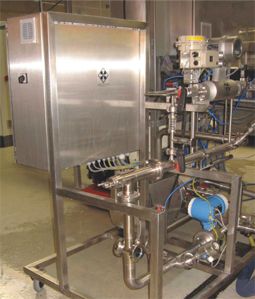Oxygen Water Units
Oxygen enrichment unit
Technology:
Cavitation
Enrichment level:
Up to 200 mg/L
Capacity:
Our smallest unit has a capacity of 10.000 L/h
The capacity is not limited because our units are modular and can also be combined.
The capacity is not limited because our units are modular and can also be combined.
Options:
With the same unit you can also enrich the water
with CO2. If you prefer oxygen water
with CO2 it can be produced with the
same unit without any changes.
With this unit CO2 will be bound by almost 100%
With this unit CO2 will be bound by almost 100%

General
information:
- Enriching the water up to 200 mg/l
- Sterility above 120 mg/l
- Mixing with CO2 possible
- Connection with existing counter pressure filling units possible
- Units from 10.000 L/h to 30.000 L/h
- Combining of more than one unit for higher capacities
- Oxygen from cylinders, tanks or our on site PSA oxygen units possible
- PH level above 7
- Oxygen conserves the water nearly endless as long as the bottle is closed
- Filling of PET and glass bottle possible
Links:
Professor Pakdamann did a lot of research about oxygen: Peroral Oxygen Therapy
Books about oxygen:
- Oxygen Healing Therapies
- Flood Your Body with Oxygen
- Oxygen to the Rescue
The Technology
Applied cavitation is the future in mixing technology:
Cavitation is the term used for the formation of cavities in liquid media. Shear forces promote the formation of bubbles. The collapse of the bubbles condenses the content. Shock waves dissolve the particles. Macromolecular changes occur. Pressure pulses arise. The implosion of the bubbles produces a new mixing process.
Cavitation is a physical, usually destructive force of flow which, with correct exploitation, can be used for obtaining molecular compounds between different liquids and gases or with other media that are difficult to mix.
Example:
If water is passed through a glass tube which narrows towards the centre, whereby the flow is gradually increased, the formation of bubbles can be seen at the point of constriction. Shear forces and implosions divide up the single bubbles into many more. A new, medial mixture is produced with increased cohesion.
Our own series of tests include the miscibility of various media such as liquid, gaseous and semi-liquid media. Experiments have been successfully carried out with chemical and petrochemical media, paints and lacquers as well as oxygen and chlorides (CO2 solutions, mixtures of two types of beverage).
Successful laboratory tests:
Blends of the most varied consistencies, such as for example, fruit juices, beer drink mixtures, oils (diesel, machine, salad and raw oils), silicone, graphite, wax and water mixtures as well as paints and pastes have been successfully combined and demonstrate the variety of possible applications of cavitative mixtures whose stability and shelf-life can be shown to be beyond the previous known mixture and preservability limits.
- Enriching the water up to 200 mg/l
- Sterility above 120 mg/l
- Mixing with CO2 possible
- Connection with existing counter pressure filling units possible
- Units from 10.000 L/h to 30.000 L/h
- Combining of more than one unit for higher capacities
- Oxygen from cylinders, tanks or our on site PSA oxygen units possible
- PH level above 7
- Oxygen conserves the water nearly endless as long as the bottle is closed
- Filling of PET and glass bottle possible
Links:
Professor Pakdamann did a lot of research about oxygen: Peroral Oxygen Therapy
Books about oxygen:
- Oxygen Healing Therapies
- Flood Your Body with Oxygen
- Oxygen to the Rescue
The Technology
Applied cavitation is the future in mixing technology:
Cavitation is the term used for the formation of cavities in liquid media. Shear forces promote the formation of bubbles. The collapse of the bubbles condenses the content. Shock waves dissolve the particles. Macromolecular changes occur. Pressure pulses arise. The implosion of the bubbles produces a new mixing process.
Cavitation is a physical, usually destructive force of flow which, with correct exploitation, can be used for obtaining molecular compounds between different liquids and gases or with other media that are difficult to mix.
Example:
If water is passed through a glass tube which narrows towards the centre, whereby the flow is gradually increased, the formation of bubbles can be seen at the point of constriction. Shear forces and implosions divide up the single bubbles into many more. A new, medial mixture is produced with increased cohesion.
Our own series of tests include the miscibility of various media such as liquid, gaseous and semi-liquid media. Experiments have been successfully carried out with chemical and petrochemical media, paints and lacquers as well as oxygen and chlorides (CO2 solutions, mixtures of two types of beverage).
Successful laboratory tests:
Blends of the most varied consistencies, such as for example, fruit juices, beer drink mixtures, oils (diesel, machine, salad and raw oils), silicone, graphite, wax and water mixtures as well as paints and pastes have been successfully combined and demonstrate the variety of possible applications of cavitative mixtures whose stability and shelf-life can be shown to be beyond the previous known mixture and preservability limits.
Further products:
This technology is also used for anti-foaming,
blending, deaeration and deaeration + carbonation.